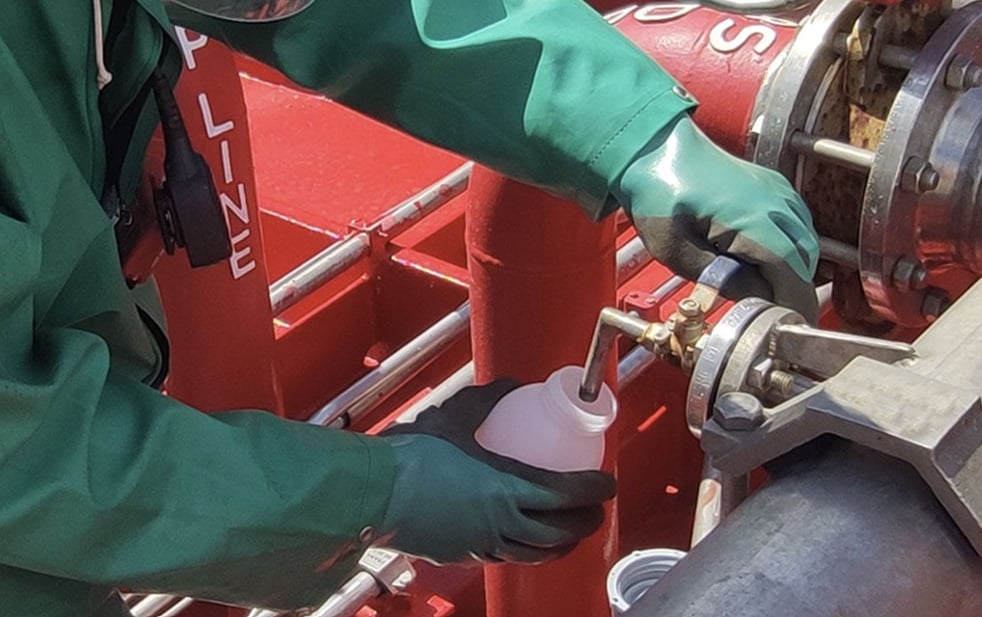Cargo samples hold significant importance in protecting tanker ship owners against potential cargo claims, necessitating the utmost care in their proper handling. This article delves into some critical aspects related to sampling.
Type of sample bottles
When it comes to which type of bottles to be used, there are a few considerations to keep in mind.
Pure acids or basic cargoes (e.g., sulphuric acid, phosphoric acid, or caustic soda) should be kept in plastic bottles (type HDPE). The reason for this is that such products will deteriorate glass over time resulting in the product containing increased levels of silica (e.g., sand or glass), but also because the bottles will become brittle and may break easily after a period of storage.
Inhibited and light sensitive cargoes are often stored in amber bottles. But if the samples are stored in dark sample lockers, then transparent bottles can be considered. Furthermore, quality complaints typically concern parameters that are not affected by light.
The downside of using plastic and amber (or dark) bottles is that they are not transparent and visual deviations (colour, water, particulate matter) in a manifold, foot or final sample are therefore not easily observed by a ship's crew assessing these samples. For immediate visual assessment, which is vital especially when assessing the manifold sample, transparent glass bottles should be used.
For vegetable oils (and other food grade products) transparent plastic bottles should be used (of a type which doesn't shrink under the effect of heated cargo). The reasons are food safety, and to prevent bottles from breaking inside the tank whereby food grade products become contaminated by glass. These cargoes may, however, be sampled in glass bottles as long as drain samples are drawn (manifold or recirculation), i.e., as long as the glass bottle is not lowered into the cargo itself.
Labelling and log keeping
Proper labelling of the samples is crucial. In some cases, vessels follow the correct sampling procedures but have poor labelling practices, such as:
- including excessive information except for the essentials,
- using only a permanent marker to write the tank number without proper labels,
- having unreadable labels.
Such labelling issues weaken the value of samples as evidence in joint witness analyses.
A label should as a minimum contain the following information:
- a) Name of vessel and voyage number
- b) Type of cargo, port of loading and discharge
- c) Details of sample (manifold, final etc.)
- d) Date and name of the person who took it.
To record the sampling in the Port Log can also serve as evidence. If the samples are sealed, then the seal number should be recorded as well.
Retention time
A concerning trend we see is that shipowners are shortening the on-board retention period of samples, disposing of them before a claim is brought against the vessel. This has led to costly settlements in cases where counter evidence could have been presented through retained samples. While sample lockers may be overfilled, it is crucial to maintain proper retention periods for potential disputes which in most cases are twelve months from the date of discharge.
Cargo surveyors
It is important to clarify the role of cargo surveyors and the misconception that issuing Letters of Protest for "failure to draw samples for the vessel" relieves the vessel from the responsibility of sampling or being involved in the sampling process. Cargo surveyors represent the cargo interests and follow their instructions, which may differ from the vessel's interests. This can result in a lack of samples or disagreements regarding the representation of available samples.
Occasionally we experience ship owners who refrained from sampling by the ship's crew because 'unilaterally drawn and unsealed samples did not bear any value as evidence'. It is essential to remember that all samples can serve as evidence and samples taken by a ship's crew are often the only evidence there is. Should a discussion regarding authenticity of samples persist, most products allow for fingerprint analyses, which would confirm that the samples are indeed representative.
By considering these recommendations and addressing the challenges related to handling of samples, the sampling procedures on board can be improved to ensure accurate monitoring of cargo quality and to secure evidence.
